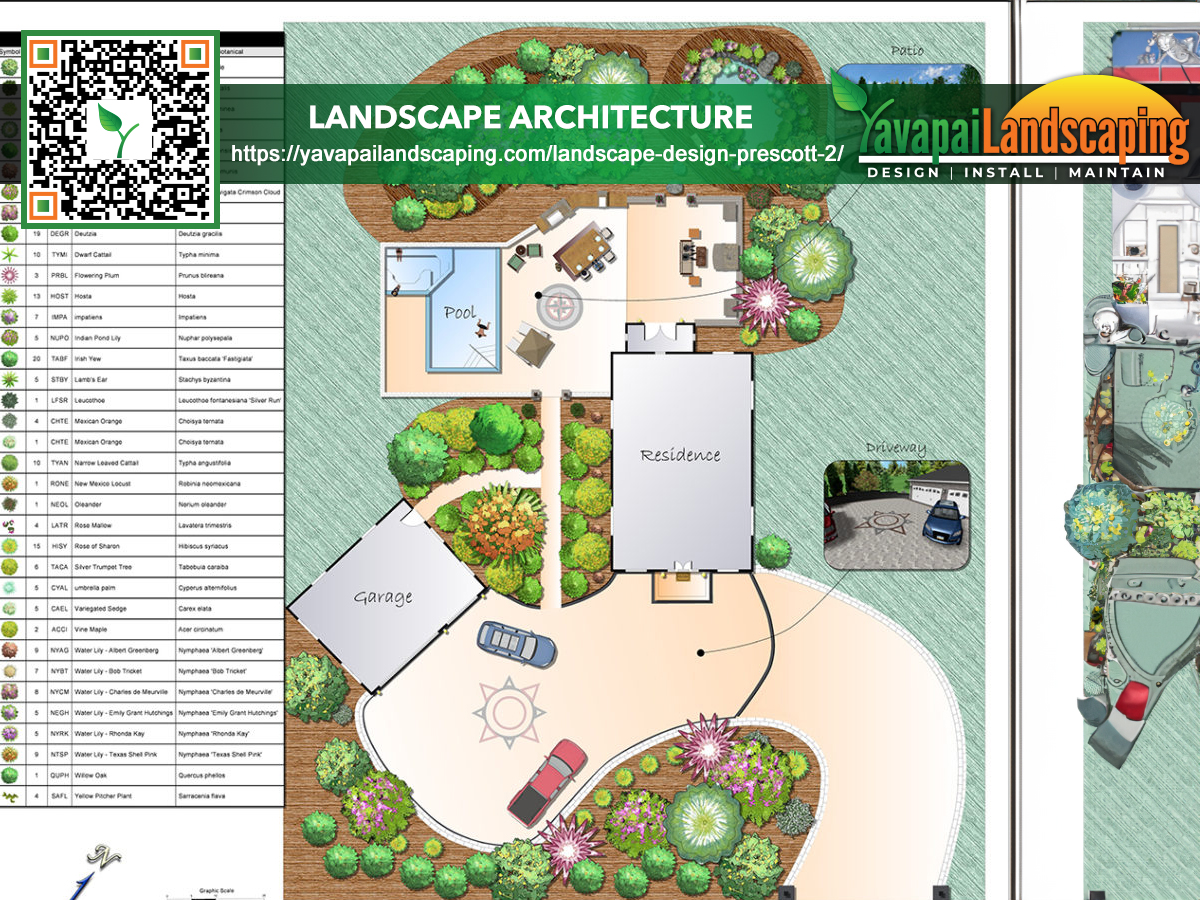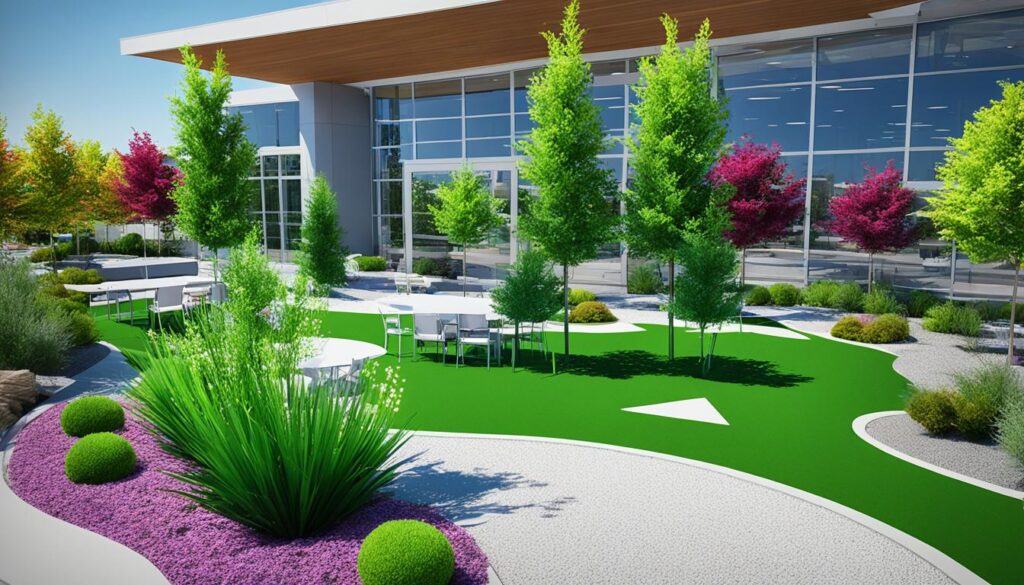
In the landscaping world, technology is changing everything. It makes the design process better and gives clients a wonderful experience. Now, with virtual reality (VR) in landscape design and augmented reality (AR) for plant visualization, designers can make amazing virtual worlds. They can also see how real plants would look. They use AI-powered plant recommendations too.
This change has made designing landscapes easier. It also brings new ways to check if designs are good for the earth. By using these new tools, landscapers can make designs that are fast, right, and green. This makes clients happy and the planet safer.
Key Takeaways
- Virtual reality (VR) makes 3D views and lets clients walk through their designs to understand them better.
- Augmented reality (AR) lets people see how plants will grow in their own outdoor spaces.
- AI helps pick the best plants for the design and the environment.
- Special tools help make designs that save water and are good for the planet.
- Seeing designs in special ways makes talking with clients easier and more fun.
Virtual Reality (VR) in Landscape Design
Landscape designers use virtual realityvisualization to change how they create. They make 3D landscape designs. This lets clients see the outdoor spaces clearly. They understand the work better this way.
Immersive 3D Visualizations
Designers use VR to show their ideas in life-like 3D. Clients can “walk” in these digital spaces. This makes choosing the best design easier. They can see sizes and looks clearly.
Client Collaboration and Walkthroughs
VR isn’t just for looking. It’s for working together and design walkthroughs. Designers and clients can make changes live. This makes sure the design is perfect from the start.
Virtual reality helps landscape designers be more creative. It makes talking with clients easier. It also gives clients amazing experiences they love.
Augmented Reality (AR) for Plant Visualization
AR plant visualization changes the game for landscape designers. They show clients how plants will look with AR. This gives a real-life sneak peek of their future gardens.
Overlay Plants in Real-World Settings
With augmented reality plants, clients get a clear view. They see how plants fit in their real outdoor spots. This method shows plants as they would really be, with size, sunlight, and all.
Clients just point their device and choose a spot. Then, they can see any plant there. This makes it easy to choose and see the effects quickly.

Visualize Growth and Maturity
The best part of AR is seeing plants grow over time. Clients watch from the start to when they’re fully grown. This growth simulation lets them know what to expect long term.
By showing real plants and their future growth, designers can be very clear. Clients understand what the design will really be. This helps them make good choices and avoids surprises later. Discover the awesomeness of this article.
AI-Powered Plant Recommendations
In the world of landscape design, AI plant recommendations are changing everything. They use smart technology to pick the best plants. This makes sure each place gets the right plants that fit perfectly.
This technology is smart because it understands what plants need to grow well. It looks at things like climate and soil to pick the best plants for an area. This makes choosing plants more about the data for good growth.
- Climate Analysis: AI knows what plants can handle the local weather and grow well.
- Soil Assessment: It also checks the soil to find plants that will do great in it.
- Water Conservation: It picks plants that need less water, which helps the environment.
But, picking plants is not just about the science. AI also looks at what plants will look good together. It helps designers create beautiful outdoor spaces. These places match what people want to see and enjoy.
| Project Type | AI Recommendation Factors |
|---|---|
| Residential Landscaping | Low maintenance, drought tolerance, aesthetic appeal |
| Commercial Landscapes | Climate resilience, water conservation, visual impact |
| Public Parks and Gardens | Biodiversity, ecological balance, seasonal interest |
With AI plant recommendations, designers can work faster and more creatively. They don’t need to spend as much time picking plants. This tech lets them focus more on making beautiful designs with the perfect plants.
Streamlined Design Processes
The landscape design field has changed a lot because of new technologies. These include virtual reality (VR), augmented reality (AR), and artificial intelligence (AI). These tools have made efficient landscape design processes better. They save time and make work more accurate.
Seamless Concept Visualization
VR and AR are now very useful for designers. They help make and see design ideas in 3D. This lets clients look at landscapes in many ways. They give feedback that designers use right away. This makes the design process faster. The final design meets what the client wants perfectly.

Intelligent Plant Selection
AI has changed how plants get chosen. It looks at the area, design wishes, and the environment. Then, it suggests the best plants for the job. This smart approach leads to accurate design processes. It cuts down on mistakes and makes landscapes last longer. Clients get choices that are well thought out. This makes the whole design process work better.
Streamlined Workflows
Using these time-saving tools, designers can get more done. They help with every step from ideas to picking plants and checking sustainability. Every part of the design work is better. Things get done quicker and with less effort. This means designers can handle more jobs well.
| Traditional Design Process | Technology-Enhanced Process |
|---|---|
| Lengthy conceptualization and visualization | Rapid 3D modeling and immersive VR/AR visualizations |
| Manual plant selection based on limited data | AI-driven plant recommendations based on comprehensive analysis |
| Iterative design revisions with potential delays | Real-time client collaboration and immediate adjustments |
| Increased risk of design errors and sustainability oversights | Optimized accuracy and sustainable design practices |
The table shows how tech has changed landscape design. It has given us time-saving tools that make work easier and better. Designers can now meet all their clients’ needs and the high standards of the job.
Sustainability Analysis Tools
Landscape pros use special tools to make green designs. These tools help look at things like how water is used, drainage, and what materials to pick. They make sure every design part is good for the planet.
Water Usage and Conservation
Looking at how water is used is super important for green designs. With special software, pros can see exactly where to save water. This means they can use the best plants for the area and find ways to save water.
Eco-Friendly Material Selection
Picking the right materials is key for going green. Tools today help designers pick eco-friendly things for walkways and walls. They check if materials can be reused or if they last long, so the design is kind to the earth.
| Conventional Material | Eco-Friendly Alternative | Benefits |
|---|---|---|
| Concrete | Permeable Pavers | Improved drainage, reduced runoff |
| Treated Wood | Recycled Plastic Lumber | Long-lasting, minimal maintenance |
| Gravel | Recycled Crushed Concrete | Reduces waste, cost-effective |
By using these tools, pros can build beautiful, eco-friendly lands. They help make smart choices. This way, the whole project is better for the world.
Improved Client Communication
In landscape design, talking well with clients is key to success. Using new tech like VR, AR, and 3D visualization tools is changing how we work together. This tech makes client communication better during the design process.
Now, clients can see designs clearly. They can look around and understand how their project will look. This stops mistakes and makes changes less expensive later. Clients can see virtual versions of their outdoor areas and add input that designers use right away.
These tools help clients join in and share what they think. It makes them feel more part of the project. This way, the final design really shows what the client wanted. It is made just the way they like.
Yavapai Landscaping Prescott offers free estimates for Prescott and nearby locations for landscaping & tree services, which include tree elimination, tree pruning, stump grinding, land clearing, storm clean-up, and emergency tree care.
